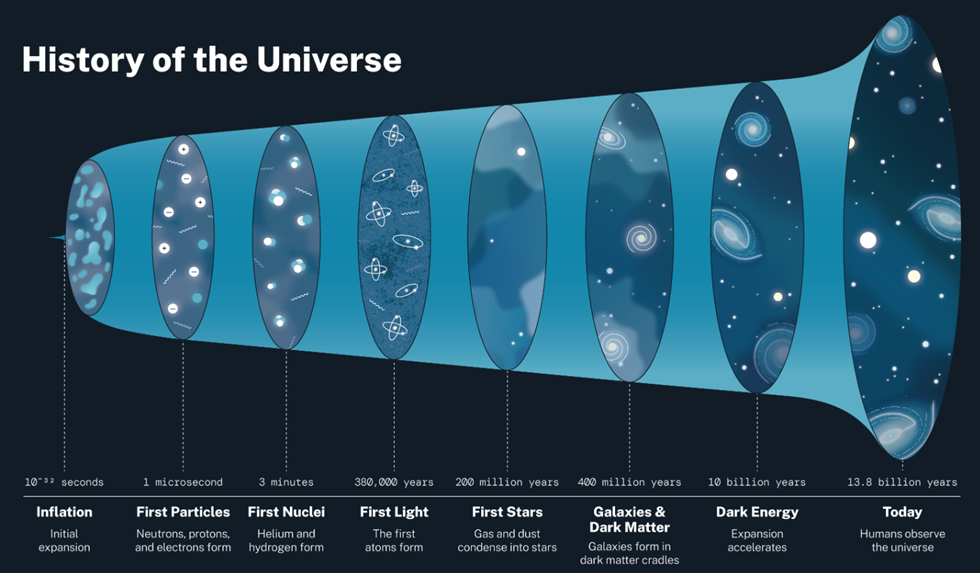Big Bang Theory
Understanding the Basic Terminology First
Before jumping into how the universe came into being, let’s become familiar with the key terms — otherwise, the concepts may feel too abstract.
- Cosmos simply means the entire universe — all of space, time, matter, and energy.
- Anything cosmic refers to things related to the universe — whether a phenomenon or a particle.
- Cosmic rays are high-energy particles (like atomic nuclei) that travel through space at almost the speed of light. These are so energetic that they can even mutate genes if exposed directly — that’s why astronauts in space need strong protection.
- Cosmology is the branch of science that studies the origin, evolution, structure, and fate of the universe.
- Anything cosmological relates to cosmology — like a theory of how the universe began.
- Astronomy is the broader science that studies celestial bodies — like stars, galaxies, comets, and even phenomena like solar winds or gravitational waves.
Now, a quick foundational understanding of the universe itself:
The universe includes everything that exists — from tiny subatomic particles like electrons and protons to massive structures like galactic super-clusters.
It includes both physical matter (things you can in theory measure or touch) and non-physical components like light, gravity, space, and time.
Scientists estimate that the observable universe contains around 100 billion galaxies, each galaxy containing roughly 100 billion stars.
Our galaxy — the Milky Way — alone may have between 100 to 400 billion stars. Just try imagining this — even if you spend one second counting each star, you won’t finish in a lifetime!
Big Bang Theory – The Birth of the Universe
Let’s now explore how all this began, according to modern cosmology.
The Big Bang Theory is the most widely accepted explanation of the origin of the universe.
- It suggests that about 13.8 billion years ago, all matter, energy, space — literally everything — was compressed into a single, extremely dense and hot point.
- This point then exploded (not like a bomb, but like a rapid expansion), and the universe has been expanding ever since.
This isn’t just a guess — it’s supported by several pieces of evidence:
- Redshift of galaxies (Hubble’s Law),
- Cosmic Microwave Background Radiation (CMBR), and
- The abundance of light elements like hydrogen and helium.
Evolution of the Universe: A Timeline
Let’s now visualize the timeline of events since the Big Bang — like a cosmic diary.
| Time | Temperature (°C) | What Happened |
| 10⁻⁴³ seconds | 10³² | Universe went through inflation — expanded super-fast, from atom-size to grapefruit-size in a flash. |
| 10⁻³² seconds | 10²⁷ | A chaotic soup of particles — electrons, quarks, etc. |
| 10⁻⁶ seconds | 10¹³ | Matter–Antimatter Formation: Particles and antiparticles (e.g. quarks & antiquarks, electrons & positrons) are formed. Most annihilate each other, but a slight excess of matter remains — this becomes the building block of our universe. Cooling began — quarks formed protons and neutrons. |
| 3 minutes | 10⁸ | Still too hot for atoms. Particles prevent light from escaping. |
| 3 lakh years (~300,000 years) | 10³ | Protons and electrons combined to form hydrogen and helium atoms. Universe becomes transparent — light could finally shine. |
| 1 billion years later | ~-200°C | Under gravity, hydrogen and helium clumped to form galaxies and stars. |
| 15 billion years | ~-270°C | Galaxies clustered, stars exploded and spread heavier elements that form new stars and even planets like Earth. |
This shows how the universe went from a chaotic energy ball to a structured cosmos with galaxies, stars, and life-supporting planets. Read More
You can draw following diagram in exams to illustrate Big Bang Theory:

The Big Crunch – Possible End of the Universe
Now that we’ve seen the birth and evolution, let’s explore one theory of how it might end — called the Big Crunch.
- Just like a ball thrown upwards eventually comes down due to gravity, if the universe’s expansion slows, it may start contracting.
- All galaxies, stars, and matter could collapse back into a single dense point — much like how it began.
- This theoretical collapse is called the Big Crunch — a reverse Big Bang.
But wait — will that really happen?
The Accelerating Expansion & Dark Energy
Recent observations say otherwise. Let’s understand this turning point.
- Edwin Hubble observed that galaxies are moving away from each other — and their speed increases the farther they are.
- That means the universe is not just expanding — it is accelerating.
Here’s the twist:
This acceleration cannot be explained by ordinary matter or gravity alone. Something else must be pushing the universe apart.
This invisible force is what scientists call Dark Energy.
- It is believed to make up about 68% of the universe’s total energy.
- It has been dominant for the past 5 billion years.
- As dark energy spreads through all of space, it keeps pushing galaxies away from each other faster and faster.
If this continues forever, the universe will become colder and emptier, possibly ending in what’s called the Big Freeze — the opposite of the Big Crunch.
The Cosmic Story So Far 😊
- The universe is vast, complex, and still mysterious.
- The Big Bang Theory provides the best explanation so far about its origin.
- Its evolution has gone through specific, well-understood stages — from particles to atoms to galaxies.
- Its future is uncertain — it might collapse (Big Crunch), freeze (Big Freeze), or do something else entirely.
- Dark energy is now the leading mystery — it might hold the key to understanding the ultimate fate of the cosmos.

Evidence for the Big Bang Theory
We’ve already learned what the Big Bang Theory says — that the universe began from an extremely dense, hot point and has been expanding ever since.
But like any scientific theory, it’s not enough to just propose it. It needs evidence — observations that support the theory. Let’s now look at the three major pillars of proof for the Big Bang.
1. Cosmological Redshift (Doppler Effect in Space)
Let’s begin with a very common experience:
When an ambulance passes by, the pitch of its siren changes — it’s higher as it approaches and lower as it moves away.
This is called the Doppler Effect. A similar phenomenon happens with light in space.
- When a celestial body (like a galaxy) moves away from us, the wavelength of light it emits stretches — this is called Redshift.
- If it moves towards us, the wavelength compresses — this is Blueshift.
Now, here’s the crucial finding:
In 1929, Edwin Hubble observed that light from almost all galaxies was redshifted — meaning they were moving away from us.
And not just that:
- The farther a galaxy is, the faster it’s moving away.
- This observation is known as Hubble’s Law, and it directly implies that the universe is expanding.
🌌 So, redshift = galaxies moving away = universe expanding = strong support for the Big Bang.

2. Cosmic Microwave Background Radiation (CMB)
Now let’s understand a truly poetic concept — the echo of the birth of the universe.
- According to the Big Bang Theory, the early universe was extremely hot.
- As it expanded, it cooled down, and at around 3 lakh years after the Big Bang, light was finally able to travel freely.
- That ancient light — still travelling today — is what we now detect as CMB radiation.
But here’s the twist:
- You can’t see it with optical telescopes (normal ones that detect visible light).
- But with radio telescopes, you can detect a faint glow from all directions in the sky.
- This glow is strongest in the microwave region, hence the name Cosmic Microwave Background.
🎯 It is considered the oldest detectable light in the universe — a direct imprint of the Big Bang.
📌 CMD/CMB = leftover thermal radiation = strong proof of early universe = confirms uniformity and origin of cosmos.
3. Gravitational Waves – Ripples in Spacetime
Let’s now come to the latest and perhaps most exciting evidence: Gravitational Waves.
First, the concept:
- In 1915, Albert Einstein, through his General Theory of Relativity, said that massive objects can bend the fabric of spacetime — and this bending is what we feel as gravity.
- If two massive bodies like neutron stars or black holes orbit each other, their motion creates ripples in spacetime, just like how throwing a stone in water creates waves.
- These ripples are called Gravitational Waves and they travel at the speed of light.
But they’re not easy to detect — they are incredibly faint by the time they reach Earth.
💡 In 2015, the LIGO observatory in the USA made history:
It detected gravitational waves from two colliding black holes that had merged 1.3 billion light years away. This proved Einstein’s prediction after 100 years!
Einstein’s General Relativity & Its Proofs
Let’s simplify Einstein’s brilliant insights:
- In 1905, Einstein’s Special Relativity said:
- The laws of physics are the same for all non-accelerating observers.
- Speed of light is constant, no matter how fast you are moving.
- In 1915, he expanded this into the General Theory of Relativity:
- Massive objects like stars or planets warp spacetime, and this warping is experienced as gravity.
- This theory led to predictions like:
- Gravitational lensing — where light bends around a massive object.
- Gravitational waves — ripples created by massive moving bodies.
Both of these have now been observed, further validating General Relativity and supporting the cosmological framework behind the Big Bang.
Gravitational Waves and the Hubble Constant
Let’s connect this back to the Big Bang and expanding universe.
We already know the Hubble Constant is a number that tells us how fast the universe is expanding.
To measure it accurately, scientists need two things:
- How far a star or system is from Earth.
- How fast it is moving away (its velocity).
Now here’s the problem — different methods give slightly different values of the Hubble constant, causing a scientific puzzle.
➡️ So, scientists proposed a new method — using gravitational waves as cosmic sirens.
- When two neutron stars or black holes merge, they release:
- Gravitational waves → used to measure distance
- Light (a flash) → used to measure velocity
Using both pieces of information, we can get a more precise value of the Hubble constant, which in turn helps us better understand the age, size, and fate of the universe.
Conclusion: Evidence Validating the Big Bang
So to recap, the three major pieces of evidence that support the Big Bang Theory are:
- Redshift (Hubble’s Law) → Proves that the universe is expanding.
- Cosmic Microwave Background (CMB) → Is the fossil light from the early universe.
- Gravitational Waves → Support both General Relativity and help measure cosmic expansion.
Together, they weave a powerful narrative — the universe began in a fiery explosion, it has been expanding ever since, and even today, light and waves from that event continue to whisper its story across the cosmos.





2 Comments